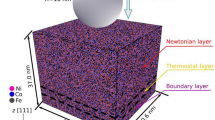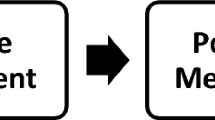Abstract
The indentation size effect (ISE) and the bilinear behavior for pure face centered cubic (FCC) metals including aluminum, nickel, silver, and 70/30 copper–zinc (α-brass) alloy using a single Berkovich indenter tip in a single test machine were investigated. The results confirmed that this behavior is mechanistic in nature and were consistent with those reported by A.A. Elmustafa and D.S. Stone [J. Mech. Phys. Solids51, 357–381 (2003)] of the ISE and the bilinear behavior using two separate indenter tips (Berkovich and Vickers) from two separate machines. Therefore, the bilinear behavior is present regardless of tip geometry or machine used. We also investigated the cause for a deviation in the continuous stiffness measurement (CSM) data from discrete data points obtained using the load control protocol at shallow depth. We conducted experiments near grain boundaries to determine if the CSM deviation at shallow depths were caused by a hardening effect due to dislocation interaction with the interface.













Similar content being viewed by others
References
W.J. Poole, M.F. Ashby, and N.A. Fleck: Micro-hardness of annealed and work-hardened copper polycrystals. Scr. Mater. 34, 559–564 (1996).
J. Mencik: Determination of mechanical properties by instrumented indentation. Meccanica 42, 19–29 (2007).
Q. Ma and D.R. Clarke: Size dependent hardness of silver single crystals. J. Mater. Res. 10, 853–863 (1995).
F.R.N. Nabarro, S. Shrivastava, and S.B. Luyckx: The size effect in microindentation. Philos. Mag. 86, 4173–4180 (2006).
N.A. Fleck, G.M. Muller, M.F. Ashby, and J.W. Hutchinson: Strain gradient plasticity: Theory and experiment. Acta Metall. Mater. 42, 475–487 (1994).
H. Gao, Y. Huang, W.D. Nix, and J.W. Hutchinson: Mechanism-based strain gradient plasticity - I. Theory. J. Mech. Phys. Solids 47, 1239–1263 (1999).
Y. Huang, H. Gao, W.D. Nix, and J.W. Hutchinson: Mechanism-based strain gradient plasticity. II. Analysis. J. Mech. Phys. Solids 48, 99–128 (2000).
J.-Y. Kim, S.-K. Kang, J.R. Greer, and D. Kwon: Evaluating plastic flow properties by characterizing indentation size effect using a sharp indenter. Acta Mater. 56, 3338–3343 (2008).
K. Durst, B. Backes, and M. Goken: Indentation size effect in metallic materials: Correcting for the size of the plastic zone. Scr. Mater. 52, 1093–1097 (2005).
Y. Huang, F. Zhang, K.C. Hwang, W.D. Nix, G.M. Pharr, and G. Feng: A model of size effects in nano-indentation. J. Mech. Phys. Solids 54, 1668–1686 (2006).
A.A. Elmustafa and D.S. Stone: Nanoindentation and the indentation size effect: Kinetics of deformation and strain gradient plasticity. J. Mech. Phys. Solids 51, 357–381 (2003).
A.A. Elmustafa, A.A. Ananda, and W.M. Elmahboub: Bilinear behavior in nano and microindentation tests of fcc polycrystalline materials. J. Eng. Mater. Technol. Trans. ASME 126, 353–359 (2004).
W. Tayon, R. Crooks, M. Domack, J. Wagner, and A.A. Elmustafa: EBSD study of delamination fracture in Al-Li alloy 2090. Exp. Mech. 50, 135–143 (2010).
W.C. Oliver and G.M. Pharr: An improved technique for determining hardness and elastic modulus using load and displacement sensing indentation experiments. J. Mater. Res. 7, 1564–1583 (1992).
W.C. Oliver and G.M. Pharr: Measurement of hardness and elastic modulus by instrumented indentation: Advances in understanding and refinements to methodology. J. Mater. Res. 19, 3–20 (2004).
A.H. Almasri and G.Z. Voyiadjis: Nano-indentation in FCC metals: Experimental study. Acta Mech. 209, 1–9 (2010).
D. Faghihi and G.Z. Voyiadjis: Size effects and length scales in nanoindentation for body-centred cubic materials with application to iron. Proc. Inst. Mech. Eng. N J. Nanoeng. Nanosyst. 224(1–2), 5–18 (2010).
G.Z. Voyiadjis and D. Faghihi: Variable (intrinsic) material length scale for face-centred cubic metals using nano-indentation. Proc. Inst. Mech. Eng. N J. Nanoeng. Nanosyst. 224(3), 123–147 (2010).
G.Z. Voyiadjis and R. Peters: Size effects in nanoindentation: An experimental and analytical study. Acta Mech. 211, 131–153 (2010).
G.M. Pharr, J.H. Strader, and W.C. Oliver: Critical issues in making small-depth mechanical property measurements by nanoindentation with continuous stiffness measurement. J. Mater. Res. 24, 653–666 (2009).
J.W. Wyrzykowski and M.W. Grabski: Hall-Petch relation in aluminium and its dependence on the grain boundary structure. Philos. Mag. A 53(4 pt 1), 505–520 (1986).
P.C. Wo and A.H.W. Ngan: Investigation of slip transmission behavior across grain boundaries in polycrystalline Ni3Al using nanoindentation. J. Mater. Res. 19(1), 189–201 (2004).
M.G. Wang and A.H.W. Ngan: Indentation strain burst phenomenon induced by grain boundaries in niobium. J. Mater. Res. 19(8), 2478–2486 (2004).
Y.M. Soifer, A. Verdyan, M. Kazakevich, and E. Rabkin: Nanohardness of copper in the vicinity of grain boundaries. Scr. Mater. 47(12), 799–804 (2002).
K.E. Aifantis, W.A. Soer, J.T.M. De Hosson, J.R. Willis: Interfaces within strain gradient plasticity: Theory and experiments. Acta Mater. 54(19), 5077–5085 (2006).
A.J. Beaudoin, A. Acharya, S.R. Chen, D.A. Korzekwa, and M.G. Stout: Consideration of grain-size effect and kinetics in the plastic deformation of metal polycrystals. Acta Mater. 48(13), 3409–3423 (2000).
B. Yang and H. Vehoff: Dependence of nanohardness upon indentation size and grain size—A local examination of the interaction between dislocations and grain boundaries. Acta Mater. 55, 849–856 (2007).
P. Sayan and J. Ulrich: Effect of various impurities on the hardness of NaCl crystals. Cryst. Res. Technol. 36, 1253–1262 (2001).
T.B. Britton, D. Randman, and A.J. Wilkinson: Nanoindentation study of slip transfer phenomenon at grain boundaries. J. Mater. Res. 24(3), 607–615 (2009).
G.M. Pharr, E.G. Herbert, and G. Yanfei: The indentation size effect: A critical examination of experimental observations and mechanistic interpretations. Annu. Rev. Mater. Res. 40, 271–292 (2010).
S. Pathak, J. Michler, K. Wasmer, and S.R. Kalidindi: Studying grain boundary regions in polycrystalline materials using spherical nano-indentation and orientation imaging microscopy. J. Mater. Sci. 47 (2), 815–823, 1–9 (2012).
D. Faghihi and G.Z. Voyiadjis: Determination of nanoindentation size effects and variable material intrinsic length scale for body-centered cubic metals. Mech. Mater. 44, 189–211 (2012).
T.C. Lee, I.M. Robertson, and H.K. Birnbaum: Prediction of slip transfer mechanisms across grain boundaries. Scr. Metall. 23(5), 799–803 (1989).
S. Vadalakonda, R. Banerjee, A. Puthcode, and R. Mirshams: Comparison of incipient plasticity in bcc and fcc metals studied using nanoindentation. Mater. Sci. Eng., A 426(1–2), 208–213 (2006).
Author information
Authors and Affiliations
Corresponding author
Rights and permissions
About this article
Cite this article
Stegall, D.E., Mamun, M.A., Crawford, B. et al. Indentation size effect in FCC metals: An examination of experimental techniques and the bilinear behavior. Journal of Materials Research 27, 1543–1552 (2012). https://doi.org/10.1557/jmr.2012.91
Received:
Accepted:
Published:
Issue Date:
DOI: https://doi.org/10.1557/jmr.2012.91




